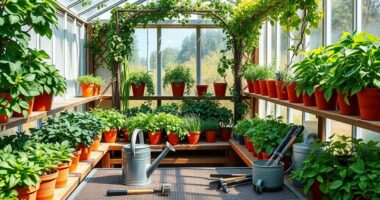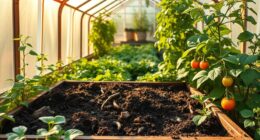In each season, you should adjust your greenhouse tasks to keep plants healthy. In spring and summer, focus on increased pest control, regular inspections, and watering more frequently during hot months. In fall and winter, reduce watering, clean to prevent pests, and monitor humidity. Consistent pest management and seasonal environmental tweaks help prevent issues early. By following these seasonal tips closely, you’ll support a thriving greenhouse environment all year—more insights await to guide your routine.
Key Takeaways
- Adjust watering routines seasonally, increasing frequency in hot months and reducing during cooler seasons.
- Increase pest inspections and preventive treatments during spring and summer when pests are more active.
- Perform regular greenhouse cleaning to eliminate pest habitats and fungal spores, especially in off-peak seasons.
- Monitor and control humidity levels year-round to prevent fungal issues and promote healthy plant growth.
- Schedule routine maintenance tasks such as inspection, pest control, and soil moisture checks based on seasonal needs.

Maintaining a healthy greenhouse requires a well-planned schedule that keeps your plants thriving year-round. One of the most critical aspects of this schedule involves managing pest control effectively. Pests can quickly undermine your efforts if left unchecked, so establishing routine inspections is essential. Regularly examine your plants for signs of pest activity, such as chewed leaves, sticky residues, or visible insects. Catching infestations early allows you to target pests before they spread. Use integrated pest management techniques, combining biological controls, organic sprays, and physical barriers, to keep pests at bay without harming your plants or environment. Staying vigilant with pest control prevents costly damage and reduces the need for strong chemicals, maintaining a healthy greenhouse ecosystem.
Regular inspections and integrated pest management keep your greenhouse healthy and pest-free year-round.
Alongside pest control, watering routines play a pivotal role in plant health. You should develop a consistent watering schedule tailored to each plant’s needs and seasonal changes. Overwatering can lead to root rot and fungal issues, while underwatering stresses your plants, making them more vulnerable to pests and diseases. Check soil moisture regularly by inserting your finger about an inch deep; if it feels dry, it’s time to water. Use a watering can or hose with a gentle spray to avoid damaging delicate foliage. During hotter months, you may need to water more frequently, while cooler seasons require less. Maintaining proper watering routines ensures your plants receive the right amount of moisture, promoting healthy growth and robust immune systems.
Seasonal adjustments are essential for both pest control and watering routines. In spring and summer, pests tend to become more active, so increased vigilance is necessary. You might need to apply preventive treatments more frequently and monitor your watering more closely, especially during heatwaves when soil dries out faster. Conversely, in fall and winter, pests typically become less of an issue, but fungal diseases may increase due to higher humidity. Adjust watering routines accordingly, reducing frequency to prevent excess moisture that encourages mold and mildew. Additionally, perform regular cleaning and sanitation to minimize pest habitats and fungal spores, particularly during off-peak seasons. Incorporating crochet tools or other protective measures can also help safeguard plants from pest damage and environmental stressors.
Incorporating these tasks into your seasonal maintenance schedule helps create a stable environment for your plants. Consistent pest control reduces the risk of infestations, while tailored watering routines ensure ideal moisture levels. Both practices require attentiveness and adjustments based on seasonal changes, but staying proactive prevents bigger problems down the line. By maintaining this disciplined approach, you’ll foster vigorous, healthy plants, and keep your greenhouse productive all year. Ultimately, a well-organized schedule that emphasizes pest control and watering routines will make your greenhouse a thriving, resilient space.
Frequently Asked Questions
How Do I Prevent Pests Year-Round in My Greenhouse?
To prevent pests year-round in your greenhouse, start by selecting pest-resistant plants that naturally deter pests. Keep your greenhouse clean and well-ventilated to reduce humidity and prevent pest buildup. Use natural pest control methods like introducing beneficial insects or applying organic repellents. Regularly inspect plants for early signs of pests, and act promptly. Consistent maintenance and integrated pest management help keep pests at bay throughout the year.
What Are the Best Eco-Friendly Cleaning Methods for Greenhouses?
Eco-friendly cleaning methods for greenhouses are essential for a sustainable space. You should start by using natural, non-toxic solutions like vinegar and baking soda for cleaning surfaces, avoiding harsh chemicals. Incorporate composting techniques to manage organic waste and promote healthy soil. Practice eco-friendly pest control by introducing beneficial insects or using neem oil. These simple, sustainable steps protect your plants and the planet while keeping your greenhouse spotless and pest-free.
How Should I Adjust Ventilation During Extreme Weather?
During extreme weather, you should adjust your ventilation system upgrades to optimize airflow and protect your greenhouse. Use natural airflow enhancement techniques like opening vents fully or installing adjustable sidewalls to improve air circulation. If necessary, supplement with exhaust fans to remove excess heat or humidity during heatwaves or storms. These adjustments help maintain a stable environment, ensuring your plants stay healthy despite weather challenges.
Can I Automate My Greenhouse Maintenance Tasks?
Your greenhouse maintenance can be automated, transforming your space into a marvel of modern farming. You can set up automated watering and climate control systems that work tirelessly, like an army of tiny workers. These systems adjust humidity, temperature, and watering schedules, so you don’t have to. With automation, you’ll save time, reduce errors, and guarantee ideal conditions for your plants year-round, making gardening easier than ever before.
What Are Signs of Structural Damage to Watch For?
You should perform regular structural inspections to spot damage indicators early. Look for cracks, warping, or bent framing, which signal potential issues. Rust or corrosion on metal parts also indicates damage that needs attention. Keep an eye on loose or missing fasteners, as well as sagging or shifting panels. By catching these damage indicators early, you can prevent further deterioration and make sure your greenhouse stays safe and functional.
Conclusion
By following a seasonal greenhouse maintenance schedule, you keep your plants healthy and your structure in top condition. Regular tasks like cleaning, inspections, and repairs are essential for preventing issues and promoting growth. Think of your greenhouse as a living organism—consistent care ensures it functions smoothly year-round. Visualize this routine as a well-oiled machine, where each task plays a critical role in supporting vibrant, thriving plants and a successful gardening season.








